Social media marketing.
If just reading those words made you want to throw your laptop off of a cliff, you’re not alone.
Between established social platforms like Facebook, Pinterest, Instagram, and LinkedIn, and the young, up-and-comers like TikTok and Clubhouse, social media content can quickly become all-consuming and overwhelming.
But whether you work for an established tech company, run a lifestyle blog, or are just looking to sign on more clients for your freelance writing, business social media marketing is an ideal way to connect with your target audience.
So, here’s what we’re going to do:
Below, we’ll cover what social media marketing is, why you should bother, and outline a no-stress, 8-step process for building an effective social media marketing strategy.
Ready?
Let’s dive in

What is Social Media Marketing?
Social media marketing is the act of using social media platforms like Facebook, Twitter, Instagram, and TikTok to attract and retain leads, customers, and clients.
There are two main social media strategies: paid social media marketing and organic social media marketing.
Also called SMM, paid social media marketing is when you pay to place advertisements on the platform to get in front of targeted audiences. This includes Facebook ads, Instagram Story ads, promoted Tweets, TikTok Spark ads, and many other formats.
Paid ads look like this on Facebook. Note the “sponsored” tag:
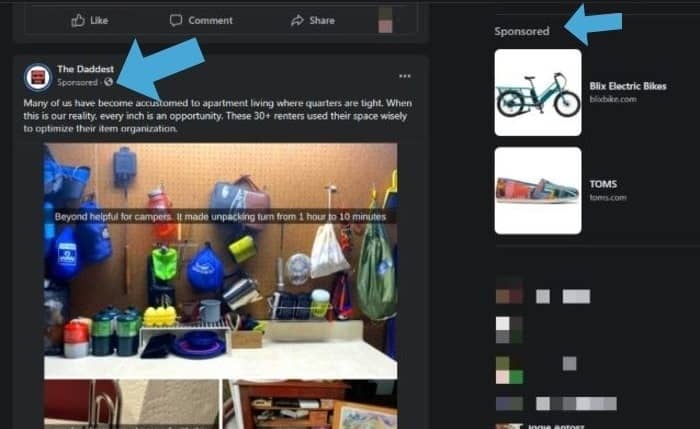
Advertising on most social media platforms allows for more precise targeting.
For example:
You could target men between the ages of 25 and 45 who live in Tallahassee, Florida, work in healthcare, and like football.
Organic social media marketing is free. It involves creating and optimizing a business profile or page, sharing interesting content, and engaging with followers.
Organic social is not a pay-to-play marketing channel, and therefore it tends to grow more slowly than social media advertising. But the ideal social media strategy should include both paid and organic.
The Benefits of Social Media Marketing
By 2025, experts expect 4.41 billion people worldwide will use one social media platform or another.
If you want to expand your blog or freelance business’ reach and build a relationship with your audience, you can’t ignore social media. These platforms take up the majority of internet users’ browsing time and garnish a lot of our attention.
Social media can help you:
- Share your expertise: Create content about and become a thought leader in your industry, and network with other leaders in your field.
- Build relationships: 81 percent of consumers buy from brands they trust. Social media marketing makes it easy to build trust by establishing a strong relationship.
- Increase brand awareness: The average person spends 145 minutes on social media a day, making it an ideal place to get eyes on your brand.
- Speed-up customer service: Today’s consumers expect brands to respond fast. Social media provides a public platform where you can respond to issues and show you care.
- Find more clients: Struggling to find more writing clients? Consistently creating engaging content to share across your social media platforms can help you connect with your ideal clients.
Social media has changed how we communicate, meet new friends, and interact with prospective clients.
And if you want to grow your business, social media plan should be a major component of your digital marketing strategy.
But where do you start?
There are dozens of platforms, hundreds of tools, and plenty of experts willing to take your money to show you how to do it right.
The good news is, it doesn’t have to be complicated. This stress-free 8-step social media success strategy will help you get started.
The 8-Step Social Success Strategy
Building a social media success strategy starts with choosing the right social media sites. The most popular social media platforms are Facebook, Twitter, LinkedIn, and Instagram. Each has its own audience, rules, and content options.
We’ll cover how to choose the right platform and then build a strategy below.
1. Set Goals & Establish Key Metrics
What do you want social media marketing to do for your business?
There are two overall types of goals: business goals and on-site goals. Each goal should have specific, measurable metrics and a time frame.
For example, you might want to use social media to increase referral traffic to your blog by 15% and gain 1,000 followers in the first six months.
Your overall business goals might include:
- Drive traffic to your website
- Increase brand awareness
- Make sales
- Increase email sign-ups
- Find leads
And your on-platform social media goals might include:
- Gain 1,000 followers
- Increase on-site brand mentions by 24%
- Get 10 reviews
After setting your goals, establish what tools you need to track social media analytics.
For example:
If your goal is to increase brand mentions by 24%, you’ll need a social media management tool like Hootsuite to track brand mentions. Followers and reviews can generally be tracked by the social media platform you’re using.
2. Research Your Audience
If you already have a target audience or buyer persona, you might be tempted to use that for your social media marketing. That would be a mistake. The way people interact on social media may be different from how they interact via email or your website.
Instead, use that data as a starting point. Who is your ideal audience? Outline their age, family status, location (if relevant), occupation, industry, income level, likes, and dislikes. Use that data to see what platform they are most active on.
For example, Facebook users stretch across age ranges, making it an ideal place for most brands.
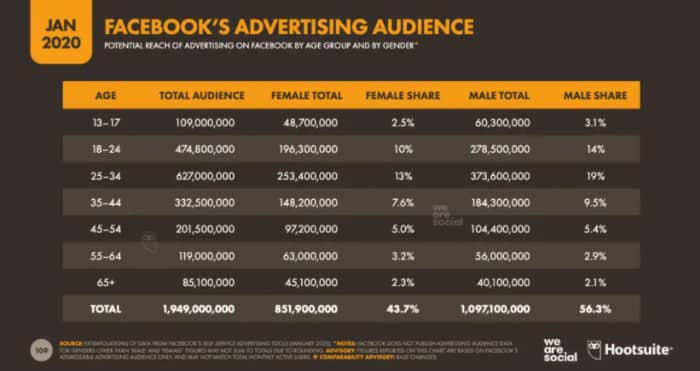
Instagram users skew older than you might expect, with the largest user base between 25 and 34 years old. Younger users tend to use TikTok, though many older users are moving to that platform as well.
Once you know where your audience is most active, it’s time to see how other businesses are approaching their social media strategy.
3. Get to Know the Competition
If you already have a list of competitors, check them out on the social media platform you’ve selected.
Create a spreadsheet and add columns for the number of followers, how many times they post, what days they post, types of content, and what content gets the most interaction.
Note that your competitors on social media may be different from your direct competitors. To find your social media competitors, look at what type of content your users share, what brands they interact with, and what groups they join.
Use the search function to find similar brands.
For example, if I want to grow my tech blog, I might search “tech blog,” then select “pages” to see businesses related to that term:
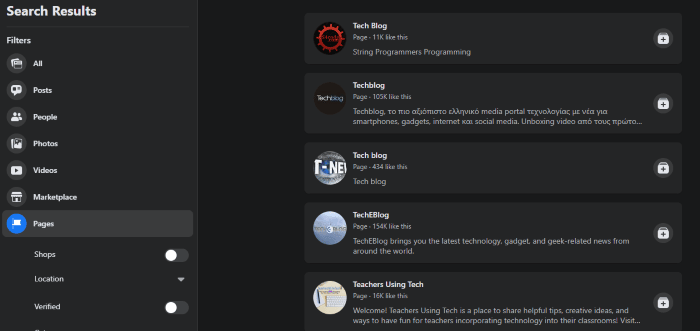
There’s a complete list of brands I’ll want to check out!
Dive deep into what is working for your competitors. Do they share Instagram Stories, or go live on Facebook every Friday? What type of content do people respond to? Do they like feel-good stories, news posts, or humorous memes?
Take notes and use this info to guide your social media marketing strategy.
4. Create Accounts & Optimize Profiles
Now it is time to set up your social media account on whichever platform you’ve decided to use.
The exact optimization process will vary by platform. However, aim to include as much information as possible.
Start by creating a business profile, which often provides access to additional insights and features. Include crucial information such as:
- Business name (Use the exact same name as your website or other platforms)
- Address or location
- Phone number
- Hours of operation (if you have them)
- Website
- A short bio that includes key terms your site targets
- Profile picture, such as a logo
- Cover photo
- Category (such as blog, publication, public figure, etc.)
Depending on the type of business and platform, you may add details like your groups, music you like, questions, and favorite books.
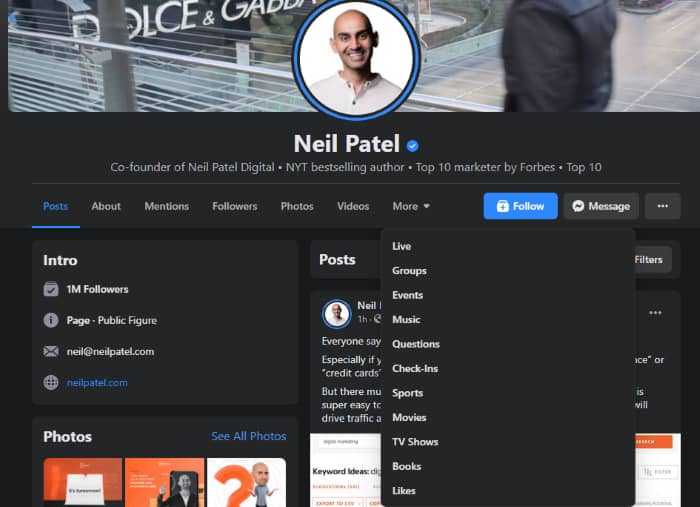
5. Setup a Content Schedule
Like your content marketing strategy, consistency is key when crafting your social media marketing plan.
But, trying to come up with clever posts every day can quickly eat up time you could spend elsewhere on your business.
Decide how many times you want to post a week (this is where your competitive research comes in handy!), then create a calendar in Google Cal or Excel and write down what you want to cover. Mix up formats – for example, you might share a mix of links, photos, and videos to keep your social media posts interesting.
Here’s an example, but feel free to adjust it to fit your business and platform:
- Monday: Meet the team: Posts about our editorial team and their background
- Tuesday: New blog post: Share top-trafficked post from the last week with an interesting quote.
- Wednesday: Industry news: Share an interesting post from a news source/popular industry blog. Include a question to drive engagement
- Thursday: Old blog post: Share older but still popular posts with interesting quotes.
- Friday: Funny/humor: Share a funny meme, photo, or story to get people talking.
Make a note of upcoming holidays or events your audience might care about. For example, a finance writer might mention tax season or the end of the third quarter.
Remember that people are social to be social, so don’t just share posts about your brand. Look for ways to entertain, interact, and start meaningful conversations.
6. Create & Share Great Content
Once you have your content schedule set up, it’s time to create and share great content.
Keep in mind, you shouldn’t only be sharing your own content! Connect with others in your industry and aim to share content your audience will find valuable.
Here are a five tips for sharing better content on social media:
- Mix up formats: Share a mix of videos, pictures, blog posts, etc. Different people like different types of content and some types of content rank better in social algorithms. (Videos tend to do well — just look at YouTube!)
- Search hashtags: See what other people are posting about your industry and share content your users will find useful.
- Use Feedly to follow industry news: This app allows you to follow specific industries so you can share content related to your field.
- Create original content: Use tools like PicMonkey or Canva to create original memes, infographics, and images.
- Schedule content in advance: Use a social media scheduling tool like HootSuite or Buffer so you can schedule posts in advance. Posting every day can quickly become a time suck.
7. Advertise
Unfortunately, every social media network uses an algorithm to determine what posts users see organically–and organic reach is falling.
In 2019, you could expect to reach around 5 percent of your audience with a post; today that same post could reach less than .08% of your followers.
Social media is pay to play – but that isn’t necessarily a bad thing. Most platforms allow you to carefully target your audience so you only reach those users most likely to like your content and interact with your brand.
For example:
LinkedIn ads can target an audience based on interests, age, location, family size, gender, and behavior. You can also use retargeting ads to advertise specifically to site visitors.
On Facebook, you can target lookalike audiences, which share traits with your target audience.
The details of advertising on each platform are beyond the scope of this article. Still, it’s important to know paid advertising on social media can be incredibly effective at increasing email sign-ups and driving traffic.
Learn about the different types of ads for each platform, what audiences they reach, and make sure to set a small budget before diving in.
8. Observe, Track, & Adapt
Remember those goals and metrics we set at the beginning? Now’s the time to see how your strategy works.
Post content for at least a month to give you time to gain traction and followers.
Then, use the insights tool from your social platform of choice to see where you stand.
For example, Facebook Audience Insights shows demographic information and what content performed well. (You can also see Instagram insights here, too.)
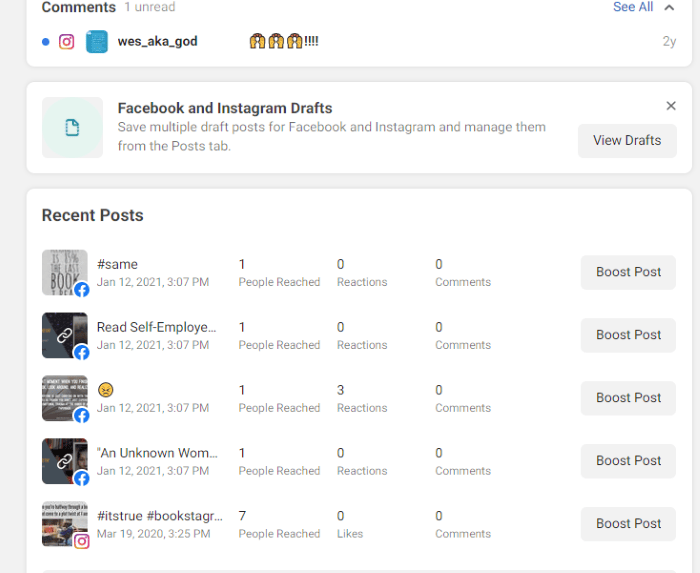
What type of content does well? Aim to post more of that content.
Did you reach your goals? Pay attention to where you fell short and choose another strategy.
For example, if your goal was to gain 1,000 followers and you fell short, consider creating a paid social media ad to increase followers.
Don’t forget to check Google Analytics to see how many social followers land on your website. The Acquisition>Social>Network Referral report will show the amount of traffic you’ve driven from social:
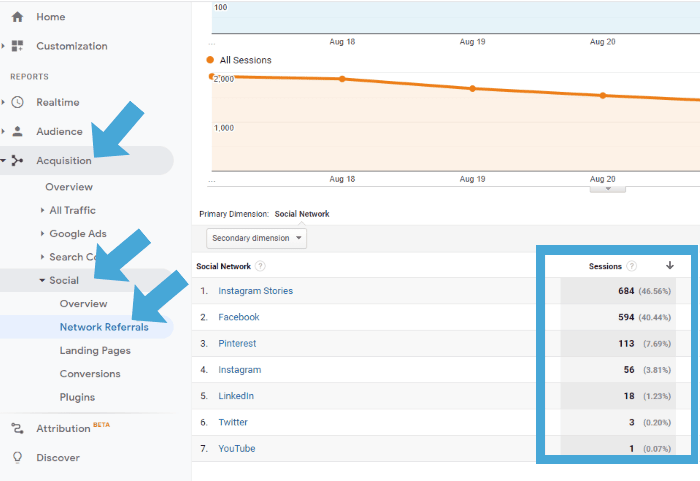
This will help you see how social media is impacting your business as a whole.
Follower count and likes might feel good, but they don’t tell you much about your business. Pay attention to direct metrics as well, such as site traffic, email list subscribers, and sales.
The Key to Social Media Marketing is Testing
Social media marketing isn’t easy – if it were, everyone would be doing it!
But this eight-step process will get you started on the right foot. Test to see what type of content your audience responds to and what helps you meet your marketing goals.
Social media features and new platforms are rolling out every week, so don’t be afraid to take a risk and try something new.
The post What is Social Media Marketing? A Simple 8-Step Strategy [2021] appeared first on Smart Blogger.

No comments:
Post a Comment